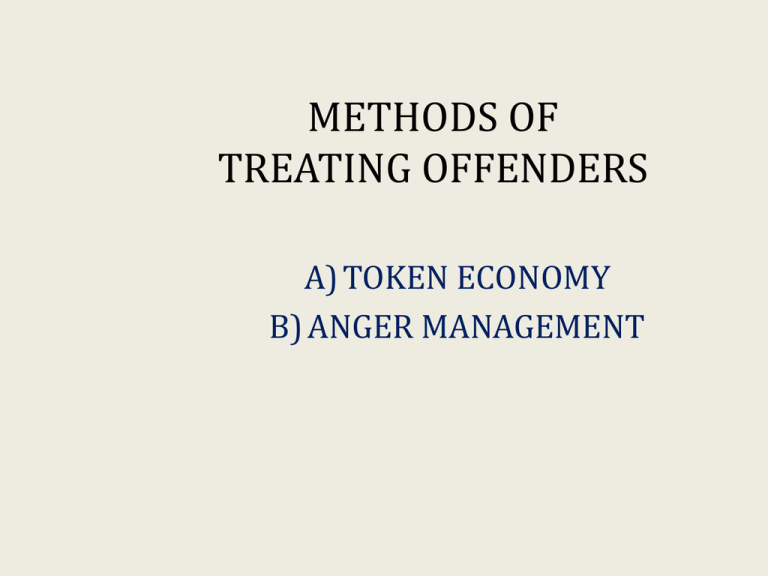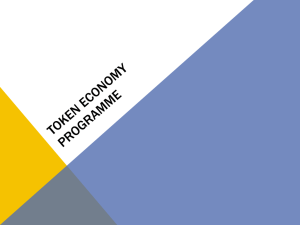Token economies
advertisement

METHODS OF TREATING OFFENDERS A) TOKEN ECONOMY B) ANGER MANAGEMENT THE TREATMENT OF OFFENDERS AND PREVENTION OF CRIME. The criminal justice system has many punishments at its disposal. It can sentence offenders to a period of imprisonment or it can use more lenient deterrents such as a suspended sentence, a period of probation, community service or a fine. Once offenders are imprisoned, some of them will be part of a treatment programme aimed at improving their immediate behaviour and reducing their chances of reoffending. Behaviour modification in the form of token economies and anger management are the 2 that we will describe and assess. • Describe and evaluate two ways of treating offenders including: - the token economy programme and one other. • Suitable examples: - punishment - anger management - social skills training. TOKEN ECONOMIES • Token economy programmes are used to obtain desirable behaviour in closed institutions such as prisons, and they are used for juvenile and adult offenders. • They are a form of behaviour modification. • These programmes started in the 1960’s and there was hope that this would be extremely successful, given the success of the use of learning theories in changing behaviour. • TASK – Think back to what you learnt about the learning theory & generalisation & operant conditioning at AS level. • Remind yourself about positive and negative reinforcement and punishment. • A token economy programme involves a system of rewards being set up for desired behaviour, sometimes with punishments to discourage behaviour which is undesirable. • Rewards are usually tokens or points, and these can be periodically exchanged for something that the individual wants. • This is an important part of the programme as the rewards must genuinely reward the person. Desirable behaviour such as co-operation and compliance is reinforced with the use of tokens. These tokens have no intrinsic value and are called secondary reinforcers. They can however be exchanged for primary reinforcers which are things that are wanted by the person. When used in prisons, many of the programmes also use negative reinforcement and punishment in order to reduce undesirable behaviour such as non compliance and aggression. Typical negative reinforcement would be removal of privileges, such as watching TV or going to the exercise yard, while a typical punishment may be isolation. • Hobbs & Holt (1976) conducted a study which involved delinquent boys. They found that when they introduced a token economy system in three juvenile delinquent centres there was a significant increase in the desired behaviours, compared to the control. - Was the token economy successful? - How could we evaluate this programme? generalisation • Generalisation is part of learning theory principles and is important when talking about token economies. • The idea is that desired behaviour, once reinforced and established in an institution, would be generalised to outside the institution so that appropriate behaviour would be established. • Generalisation in learning theory is when a behaviour learned in one situation is transferred to another, or when learning of one behaviour is transferred to a similar behaviour. • Do you think that prisoners on such programmes would generalise once leaving an institution? PROCEDURE OF A TOKEN ECONOMY PROGRAMME It is very important that there are clear definitions of: • • • • • what is a desired behaviour what is a token how tokens are allocated what is a reward how there will be gradual changing of the giving of tokens to shape the behaviour • how many tokens there are for each reward • how the reward will be removed once the behaviour is achieved Evaluation of token economy programmes • TASK Using the textbook/ internet, evaluate the use of TEP’s in Criminal Psychology. - Do they work? What evidence do you have? - Why TEP’s may not work - Advantages of TEP’s - Think about recidivism In the 1970’a when TEP’s were evaluated to see if they worked, it was concluded that they did not! Ayllon and Milan (1979) reviewed a number of programmes and found that they worked for certain behaviours e.g. the general keeping of rules and control over interpersonal aggression. Milby (1975) found that programmes were successful in psychiatric hospitals and helped in preparing someone to leave hospital BUT we do not know if the effects worked long term. Field et al (2004) looked at a TEP used with young people with behavioural problems. The programme was generally effective although there were still a number of young people who did not respond. Later these youths were placed on a special programme where the rewards were more immediate and more frequent and the results were positive. This suggests that the programme should be designed so that the rewards suit each individual. REASONS WHY TEP’S MAY NOT WORK • Staff are not committed to the programme, so they do not focus on it sufficiently. • Inconsistent rewards are given for the same behaviour. • There is a failure to plan for transferring to the home environment or any environment outside the institution. ADVANTAGES OF TEP’S • There should be no delay between the desired behaviour and the reward. • Anyone can give the tokens. • Clear rules mean staff know when to award a token, so the programme is relatively easy to administer. EVALUATION + Can be administered by anyone (with training) and tokens and rewards are relatively cheap, so the programme is not expensive and there are more benefits than costs. + Has been found to be successful by many studies, even though approx. 10 – 20 % of people do not respond well to TEP’s. - Learning may not transfer to the home environment, so there might be recidivism. - Programmes have to be carefully planned and controlled, and there are many areas where problems can occur such as lack of consistency from staff. POSSIBLE EXAM QUESTIONS 1. Outline one way of treating offender behaviour. (3 marks) 2. Evaluate the use of token economies in reducing offending behaviour. (5 marks) 3. The probation service is looking into ways to treat offenders and reduce recidivism. Describe and evaluate the token economy method with respect to how it treats offenders and whether it is useful in reducing recidivism rates. (12 marks)






